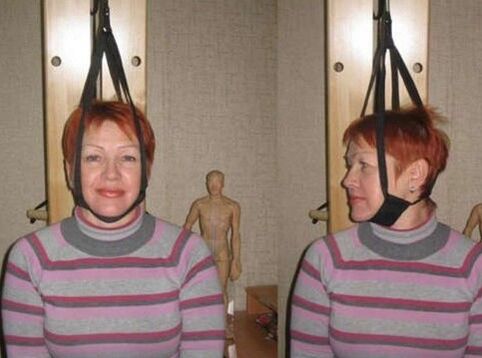Osteochondrosis of the cervical area is a dangerous disease, and if it is not treated, you can be a disabled person. Facing this disease, many people think about how to deal with it. Let's think about the intricacies of this disease.

Cervical spinal osteochondrosis is a disease that has symptoms, stages, causes and treatment itself.
Disease
Cervical vertebral osteochondrosis is a progressive disease, characterized by degenerative, as well as dystrophic changes in the disc between vertebrae.
The cervical department is represented by seven vertebrae and is the most portable, but the muscle corset is less advanced. He is responsible for sliding his head to his side and his turn.
The stage of the disease travel
The development of the disease occurs in four stages, and its degree is distinguished:
- 1 degree.This stage is characterized by the instability shown in the initial destruction of the disc.
- 2 degrees.At this stage, disc promotion is indicated. The distance between the vertebrae is reduced, the destruction of the fiber ring begins, while the pain occurs as a result of pinching the nerve.
- 3 degrees.The ring was eventually destroyed, and the hernia was formed between the vertebrae. The spine is very defective.
- 4 degrees.He is the hardest. Each movement causes severe pain. With a strong increase in bone tissue, the disease leads to defects.
The picture describes the stage of the development of osteochondrosis of the cervical spinal cord
IMPORTANT! At each level - different symptoms and different methods of treatment are used. Doctors take steps regardless of the level of the disease, as this allows you to improve the quality of life of the patient.
Cause
To date, strong growth from the age of 18 to 30 has been observed. Previously, the disease was only found in the elderly and sometimes in people under the age of 40. The causes of cervical osteochondrosis are different.
Some of the main stand out:
- Overweight;
- Posture changes;
- Scoliosis of the spinal cord in the neck;
- cervical spinal canal injury;
- damage to the metabolism process;
- weight lifting continuously;
- poor physical training;
- pressure;
- the image of an inactive life;
- the presence of infectious diseases;
- Frequent hypothermia.
If normal back pain appears, then this can signal the spine. One of the possible diseases is the instability of the cervical vertebra. What is the cause of the disease and the main symptoms? What complications can be if you do not start treatment on time?
Cervical vertebral osteochondrosis is closely associated with muscle cramps that limit vertebral mobility. As a result, the blood circulation process, the posture is violated. All of these factors launch the dystrophic process in the disc located between the vertebrae. As a result, the nerves pinched.
Improper position during sleep can cause the development of osteochondrosis of the cervical spinal cord
Manifestations of disease
Often, the signs of cervical osteochondrosis manifestations are associated with the failure of the blood circulation.
Normal is:
- Dizziness where loss of consciousness is possible;
- frequent headaches;
- Slim in movement coordination. Often, the disease is presented in Gait disorders;
- Usually ringing in the ear, as well as hearing disorders;
- the appearance of snoring;
- reduction of vision;
- appearance of hoarse, hoarse voice;
- Losing sensitivity in the finger.

IMPORTANT! When some symptoms are indicated, consult your doctor for advice. Don't meditate.
Symptoms of cervical osteochondrosis
Osteochondrosis intervertebral cervical area is indicated by the following symptoms:
- Korshka. The patient feels the pain given to the blade or shoulder zone. He also felt a tingling in his fingers, brushes, lower arms. These symptoms are directly related to a pinch of nerves;
With cervical osteochondrosis of the spinal cord, pain is given to the shoulder
- back compression;
- vertebral artery;
- Irrititive-Reflectory. They are expressed in acute and severe pain in the neck and occipital area, which shows themselves during sneezing, as well as after sleep or sharp turns to the right or left of the head;
- Cardinal syndrome. These symptoms are similar to angina pectoris. Pain is paroxysmal and prolonged. Strengthening occurs if coughing appears, one sneezes, and with a sharp head turn.
IMPORTANT! If inflammation of the cervical area osteochondrosis occurs, the symptoms are expressed in a brighter form.
Treatment
Cervical spinal osteochondrosis is treated, but it takes a lot of time. In addition, it should take place in the hospital and comprehensively.
Doctors use various steps and funds in the fight against the disease. Between them:
- Hivamat is a procedure for electrostatic vibro sequences on specialized tools. It is anesthetizes, has an anti -inflammatory effect, allowing you to remove edema and muscle tension. According to statistics, two sessions to relieve the pain syndrome are enough.
- MLS laser therapy. This procedure is intended to relieve pain, removal of inflammation, and regeneration of soft tissue. This method is innovative, but successfully used to treat osteochondrosis of the spinal canal and other spine.
- Electrophoresis. This is a procedure in which medications under the skin are introduced using a pulse during electricity. It has analgesic, anti -inflammatory effects.
- Application of ozokerite. Treatment with mountain candles and paraffin. After using the composition, the pain is covered with film. It does not cause unpleasant sensations and has a positive effect.
Exercise for cervical spinal osteochondrosis. Simplicity and effectiveness. A daily systematic approach is required
IMPORTANT! All procedures are prescribed by the doctor depending on the level of the disease and the individual characteristics of the patient. They are always selected individually.
The cervical spine in the human body is an important part, and the problem in its work is provoked by negative consequences. In addition, neglected diseases related to the neck can affect the thoracic area. Exercises for cervical spine columns will help maintain health and continue mobility in this bone muscle system zone.
In addition, the procedure is added:
- Analgesic, antispasmodic and anti -anti -anti -anti -anticipation drugs;
- using gel, cream, ointment for tissue recovery;
- healing of physical exercises;
- reflexotherapy;
- Hirudotherapy;
- massage sessions;
- Dry stretch.

IMPORTANT! Often, conservative methods are used, but, unfortunately, surgical intervention can be prescribed in difficult situations.
Dry explosion - an effective method in the treatment of cervical osteochondrosis of the spinal cord
As a result of osteochondrosis of the cervical spinal cord
The disease can cause serious consequences, such as:
- Protabius. This complication is characterized by the prominent nucleus of the pulpo -the intervertebral disc, where the ring does not destroy;
- Intervertebral disc hernia. It occurs when the fibrous ring is destroyed;
- vertebral bone bone;
- salt deposition;
- The appearance of sclerotic plaques in vessels and other disruptions.
IMPORTANT! Any vascular disorders are the most dangerous consequences, as brain supply with blood is disrupted, which can cause severe disease.
Cervical spinal osteochondrosis requires treatment. It takes a lot of time, so you need to be patient and strictly follow your doctor's advice and advice.
























